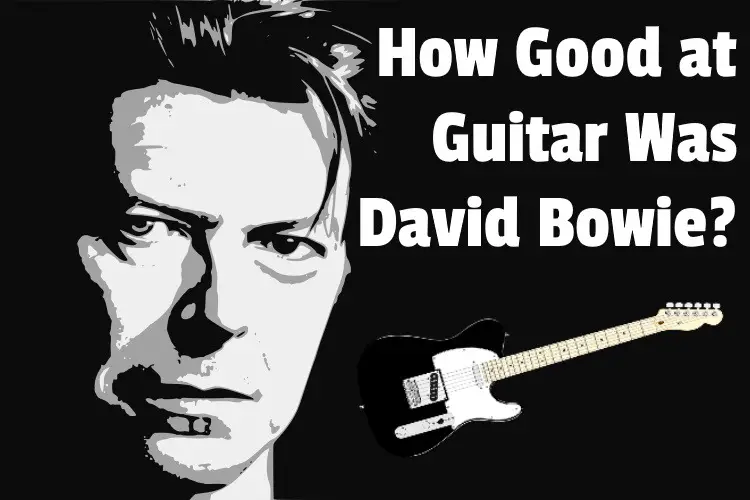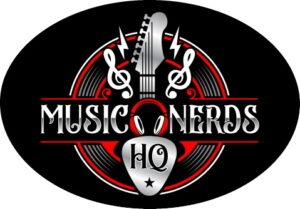
David Bowie was an amazing musician. But he also tended to surround himself with even more amazing lead guitarists. So how good at guitar was David Bowie?
Here is what I know from seeing him live twice:
David Bowie was an excellent rhythm guitar player. But ultimately, the guitar was his method for songwriting and not his focus in concert. So, for that reason, he sought out notable lead & rhythm guitarists to flesh out the sound and enable him to just focus on singing when performing live.
So ultimately, it’s a lot like Jagger and Bono. When he had a guitar on stage, it was mostly a part of prop and secondary to the feel of the music.
Tony Visconti, who worked closely with Bowie, reiterated:
“David was an exceptional guitarist, but he was terrified of playing the string instruments in front of anyone that wasn’t him.”
Let’s find out if Bowie lacked confidence in his guitar skills and if he ever played it onstage. And we’ll also look at whether any notable guitar parts on his records are actually him.
Let’s get into it.
David Bowie on stage playing acoustic guitar pic.twitter.com/I1ck6a3f5i
— peterkidder (@peterkidder) September 4, 2020
What instruments can David Bowie play?
David Bowie was a multi-instrumentalist who could play guitar, keyboards, saxophone, harmonica, piano, mandolin, cello, and stylophone, which is a vintage mini-synthesizer.
In the 70s, Bowie was often seen playing an acoustic guitar in live shows. But that tended to go away in the 80s and rarely came back. And again, that was so he could focus on singing and performing.
Bowie also played the keyboard and keys in Iggy Pop’s touring band in the 70s.
The left-handed musician got the chance to work with some great guitarists like Steve Ray Vaughan, Earl Slick, Robert Fripp, Carlos Alomar, and, of course, Mick Ronson, who was his first main sidekick.
His next creative streak led him to work with fantastic pianists like Roy Bittan and Rick Wakerman. He played Saxophone on “To Know Him Is to Love Him” from Steeleye Spans’ album “Now We Are Six.”
David Bowie playing an acoustic 12-string guitar to promote the release of Space Oddity, 1969. 📷 Michael Ochs. pic.twitter.com/mNO9AW6Who
— Rock N Roll Pictures (@RockNRollPics) November 12, 2020
Did David Bowie play guitar on his albums?
David Bowie played guitar on every album except 1983’s “Let’s Dance”. That album featured Stevie Ray Vaughn on lead guitar and producer Nile Rogers provided all the rhythm guitar parts.
Much of his output in his late 60s and 70s, including most albums, had a reasonable amount of guitar parts and a good strumming requirement that Bowie fulfilled competently.
Here are top albums in which David Bowie played guitars:
- David Bowie- 1969
- The Man Who Sold The World- 1970
- Hunky Dory- 1971
- The Rise and Fall of Ziggy Stardust-1972
- Aladdin Sane- 1973
- Diamond Dogs- 1974
- Young Americans-1975
- Heroes-1977
As I mentioned, the only album on which Bowie did not play guitar was his 15th studio album, “Let’s Dance”.
After the release of Scary Monsters, Bowie entered a period of musical collaborations and decided to make a fresh start.
And by that, I mean he was broke and pretty much willing to sell his soul for a hit single to regrow his bank account.
The sessions of this album featured an entirely new version of Bowie; cleaned up, sanitized, radio-friendly, and MTV-friendly.
Many long-time fans (myself included) hated that record. But it did exactly what he hoped.
The album contained components of dance-pop, dance-rock, and new wave. It reached number one in numerous countries, becoming Bowie’s best-selling album.
Hear David Bowie’s 1974 cover of Bruce Springsteen’s ‘Greetings From Asbury Park’ song “Growin’ Up,” featuring Ronnie Wood on guitar https://t.co/fwbKTl52C0 pic.twitter.com/A4TfKIeEGH
— Rolling Stone (@RollingStone) January 12, 2021
Did David Bowie play guitar in concert?
David Bowie often played guitar in concerts in the 1970s. However, by the 1980s, he had ceased playing guitar regularly during his shows so he could focus on singing and performing.
But that doesn’t mean he never played again onstage.
His go-to-guitars were Supro Dual Tone, classic Fender Telecaster, Fender American Original 50s Telecaster, Guild 12-String F-512.
Of all these concerts, his 1983 concert “The Serious Moonlight Tour” around the time he released “Let’s Dance“, was one of the biggest tours ever, which luckily, I attended.
And I have no recollection of him playing guitar at that show. Instead, the guitar parts were handled by Earl Slick and Carlos Alomar.
But in all honesty, the 2nd time I saw Bowie, in 2004, it was a MUCH better show.
Earl Slick was around for that show too, along with the relatively unknown Gerry Leonard, also on guitar. And I think Bowie put on a guitar for a song or 2 (New Killer Star is one) but not much beyond that.
And despite being a lefty, he played guitar right-handed.
Can a lefty play a right-handed guitar? To be honest, there are a lot of figures in rock history who were left-handed players, and not all of them played that way. Luckily, I discussed it in my recent article, giving you the who’s who of lefties who play right-handed.
Just click that link to read it on my site.
David Bowie and guitar during the Sound Vision tour of 1990 by Donna Santisi. pic.twitter.com/9G0SCBd0Rv
— Davenant 📸 (@MarcDavenant) January 10, 2021
How did David Bowie choose his guitar players?
David Bowie selected his guitar players based both on musical ability as well as how he got along with them. And he always tended to have one that was more rock-oriented, such as Mick Ronson or Earl Slick, and one who was more experimental, such as Robert Fripp or Adrian Belew.
Bowie was fortunate enough to work with many of the best guitarists from the rock era.
These artists played a significant role in shaping his musical identity and created the sound that made Bowie’s style more fluid.
Looking back at Bowie’s long career, here is a look at top guitarists that he worked with:
Mick Ronson:
Bowie’s relationship with Mick was undoubtedly the most productive. The duo met in 1970 and instantly connected. The same year, Ronson joined Bowie’s band. They worked on breakthrough albums like Hunky Dory, Spiders from Mars and Aladdin Sane, and The Rise and Fall of Ziggy Stardust.
Carlos Alomar and Earl Slick:
Slick first boarded Bowie’s team in 1974 for the Diamond Dogs tour, while Alomar took the responsibility of guitar duties on Young Americans.
Slick paired with Alomar for the track “Fame”- a smashing hit Bowie wrote with John Lennon.
If you are not familiar with this story, read my recent article where I looked at John and David’s close relationship and how David helped Lennon’s family fill the void that Lennon’s passing has created after Lennon’s death.
Just click that link to read it on my website.
The guitar riffs of Slick and Alomar leaned more towards the unique rock-fun sound like Young Americans and Station to Station.
Other guitarists that Bowie worked with are:
- David Torn
- Reeves Gabrels
- Adrian Belew
- Stevie Ray Vaughan
David Bowie and Mick Ronson on stage during the Ziggy Stardust tour, 1972. pic.twitter.com/xoT9PzzVt0
— Legends Of Classic Rock (@lofcr1) September 19, 2021
Who was David Bowie’s best guitarist?
Mick Ronson was the best guitarist David Bowie ever had. His work with David in the early 1970s revolutionized music forever. Ronson played lead guitar on The Man Who Sold the World, Hunky Dory, Ziggy Stardust, Aladdin Sane, and Pin Ups.
Mick became the bedrock for Bowie’s iconic Ziggy Stardust persona on stage.
Mick Ronson contributed to Bowie’s music both as a guitarist and producer. He helped intensify Bowie’s music during the classic early 70s era.
Sadly, he passed away in 2016. But while he left Bowie in the 70s, after Bowie retired the Ziggy persona, Ronson did make 1 appearance later on Bowie’s Black Tie White Noise album from 1993.
Bowie himself went on record and extolled Ronson’s contribution to his seminal work that he produced between 1970 and 1973.
According to a website article, the audio for this same interview has been used in the 2017 documentary “Beside Bowie”. It shows long-time Bowie guitarist Earl Slick describing Ronson as “the best guitarist David Bowie ever had.”
Conclusion
David Bowie made a wealth of music, producing countless unforgettable tracks that wove truth and imagination together. He is said to be the trendsetter and a bit timid about his guitar skills.
Many think David was not as good as other accomplished guitarists he has worked with, such as Mick Ronson, Carlos Alomar, or Robert Fripp.
But his fans and the people who have worked with him recall him as an excellent guitarist. He played some of the best rhythm guitars in most of his tracks and achieved commercial success.
Image by Cristian Ferronato from Pixabay and Image by Chrom72 from Pixabay
